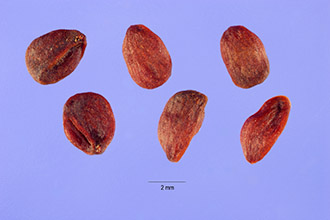Toyon
Scientific Name: Heteromeles arbutifolia (Lindl.) M. Roem.

| General Information | |
|---|---|
| Usda Symbol | HEAR5 |
| Group | Dicot |
| Life Cycle | Perennial |
| Growth Habits | ShrubTree, |
| Native Locations | HEAR5 |
Plant Guide
Uses
Ethnobotanic: Many tribes in California gathered the fruit for food including the Salinan, Maidu, Karok, Sierra Miwok, Pomo, Luiseno, Hupa, Wappo, and Yuki. It is important to wait until the red fruits are very ripe before picking and eating them. They are boiled or roasted before consuming or sometimes they are eaten raw. Among the Sierra Miwok, the fruits were boiled and baked in a deep narrow earth oven. Another preparation technique was to store the fruits in a basket for two months until they had softened and then they were parched with coals in a basket and eaten. The fruits were reputed to be slightly puckery. The Yuki made the leaves and bark into a decoction for medicinal use in treating stomachache and various body aches and pains. Wildlife: Upland game birds such as band-tailed pigeons and songbirds including northern red-breasted sapsuckers, thrashers, and wren-tits consume the fruits. Small mammals such as the large-eared wood rat and the portola wood rat also feed on the fruits.
Status
Please consult the PLANTS Web site and your State Department of Natural Resources for this plant’s current status and wetland indicator values, , Use soil moisture sensors to measure the soil moisture of Toyon.
Description
General: Rose Family (Rosaceae). This evergreen shrub reaches up to 10 meters in height. It has a grayish trunk and puberulent branches. The elliptic to oblong leaves are simple and short petioled. They have spines along the margins and are thick and leathery. The small, white flowers are arranged in large terminal clusters and each flower has 5 petals, 5 sepals, and 10 stamens. The fruits are bright red or yellow drupe-like pomes with dry pulp and contain 3 to 6 seeds. They persist through winter. J.E. & Bonnie McClellan © California Academy of Sciences @ CalPhotos
Distribution
For current distribution, please consult the Plant Profile page for this species on the PLANTS Web site. The shrub is found in chaparral, oak woodland, and mixed evergreen forest below 1300 m. throughout the California floristic province and into Baja California.
Establishment
Seeds: Clean off as much of the pulp as possible and then put the fresh seeds in water and let them rot for one week. This is a good technique for getting the seed separated from the fleshy part of the fruit. If the seeds have been stored, they need three months stratification before planting. Plant the seeds directly in the ground in the fall and water them. Plant them in full sun in almost any soil type. If the seedlings come up too thick, thin them. This shrub makes a magnificent hedge plant and birds love the fruits. Seeds may also be planted in containers for the first year and then planted out in the second fall. Cuttings: Cut 4-5 inch tips of the semi ripe wood in early summer and strip off the lower half of the leaves and dip each cutting into a rooting hormone. Put the cuttings into a rooting medium such as perlite-sand in four-inch pots spaced about one-half inch apart. Keep the pots watered and sheltered from wind and direct sun. The cuttings take about two to three months to root. New growth on the tops of the plants signifies root development. After rooting, transplant each plant into individual pots, one plant per pot. Plant each plant in a light, loose soil in partial shade, and water it, keeping it moist and protecting it from hot sun, winds, and animals. The following fall if the plant is growing vigorously, plant it out in full sun. If the plant is small and grows slowly, wait a second year and plant it outdoors the following fall.
Management
Toyon can be pruned in winter, when the branches with fruits are cut for decorations. The shrub may be trained into a small tree by gradual removal of lower branches, or pruned into a large shrub of multiple boles and rounded crown. Trimming may increase the abundance of berries by increasing the amount of year-old wood. Cultivars, Improved and Selected Materials (and area of origin) HEAR5 is widely available from native plant nurseries within its range. Contact your local Natural Resources Conservation Service (formerly Soil Conservation Service) office for more information. Look in the phone book under ”United States Government.” The Natural Resources
Conservation
Service will be listed under the subheading “Department of Agriculture.”
